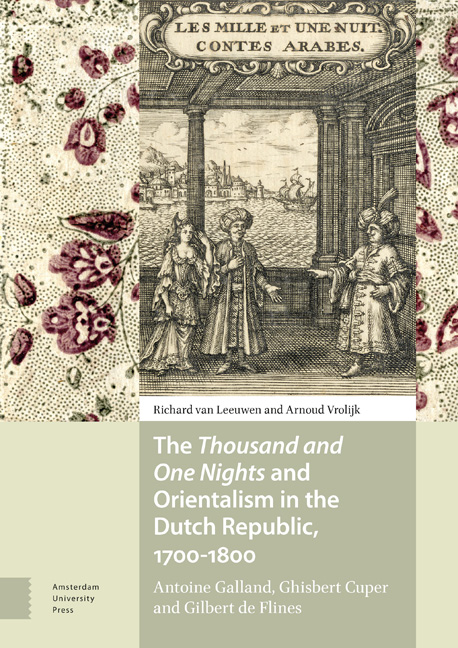 Thousand and One Nights and Orientalism in the Dutch Republic, 1700–1800
Thousand and One Nights and Orientalism in the Dutch Republic, 1700–1800 Book contents
- Frontmatter
- Contents
- Introduction
- 1 The Thousand and one nights and literary Orientalism in Europe
- 2 Dutch Orientalism before 1700
- 3 Antoine Galland and Ghisbert Cuper
- 4 The early editions of the Nights
- 5 Gilbert de Flines
- 6 Later editions in the eighteenth century
- 7 Dutch Orientalism in the eighteenth century
- Conclusion
- Appendix 1 Bibliographic survey of Dutch editions, 1705-1807
- Appendix 2 The David Coster engravings
- Appendix 3 Text samples of the Dutch Nights
- Appendix 4 French and Dutch quotations
- Illustration credits
- Bibliography
- Index
5 - Gilbert de Flines
Published online by Cambridge University Press: 21 November 2020
- Frontmatter
- Contents
- Introduction
- 1 The Thousand and one nights and literary Orientalism in Europe
- 2 Dutch Orientalism before 1700
- 3 Antoine Galland and Ghisbert Cuper
- 4 The early editions of the Nights
- 5 Gilbert de Flines
- 6 Later editions in the eighteenth century
- 7 Dutch Orientalism in the eighteenth century
- Conclusion
- Appendix 1 Bibliographic survey of Dutch editions, 1705-1807
- Appendix 2 The David Coster engravings
- Appendix 3 Text samples of the Dutch Nights
- Appendix 4 French and Dutch quotations
- Illustration credits
- Bibliography
- Index
Summary
As already noted above, both in the 1719 and 1738 Dutch editions the translator identified himself only by his initials ‘G.D.F.’. He was in all probability Gilbert de Flines, a silk merchant from an Anabaptist Mennonite family in Amsterdam. This identification is supported by the dedication of the work to Pieter and Arent van der Meersch, two prominent members of the same religious minority in Amsterdam and scions of a wealthy family of soap manufacturers with strong cultural interests. The De Flines family hailed from French Flanders and migrated from their native town of Wattrelos to Antwerp in 1566, and from there to Amsterdam in 1584. They distinguished themselves as silk weavers and textile merchants with commercial interests in Asia, London and the British colonies in North America. The family was economically successful, but as Dissenting Protestants they found themselves outside the inner circle of political influence, the so-called regenten. In Nederland’s Patriciaat, the genealogical standard work on the Dutch grande bourgeoisie, a thorough survey of the family did not appear until 2007. From the early years of the eighteenth century, members of the family started leaving the Anabaptist community and entered either the Remonstrant Church or the Walloon Reformed Church (Église wallonne) in order to remedy this problem of social exclusion, but with varying success. Prominent members of the family in the late eighteenth or early nineteenth centuries include Hendrik de Flines (1760-1832) and Quirijn de Flines (1771-1847), who were both active in the world of art and learning. In modern times the family has been closely associated with the world of stationery, printing and publishing.
Gilbert de Flines, the Dutch translator of the Nights, was born on 19 February 1690 as the son of Philips (1640-1700) and his second wife Agatha Steyn (1661-1697), the daughter of a Haarlem burgomaster. His father Philips was not only an enormously wealthy silk manufacturer and merchant but also an art collector and amateur botanist. The Walloon painter Gerard de Lairesse (1640-1711) made two sketches of him as a young man amidst his collection of paintings, books, drawings and statuary, and in 1682 painted his portrait in oils. The same painter also decorated his imposing house Messina on Herengracht 164. Philips de Flines also owned a country pile called Spaarenhout, which no longer exists in its original form.
- Type
- Chapter
- Information
- Thousand and One Nights and Orientalism in the Dutch Republic, 1700–1800Antoine Galland, Ghisbert Cuper and Gilbert de Flines, pp. 79 - 90Publisher: Amsterdam University PressPrint publication year: 2019


